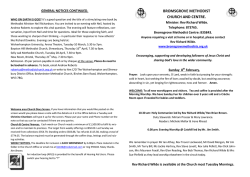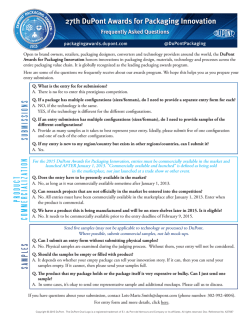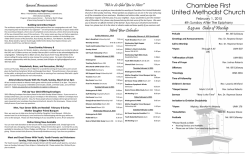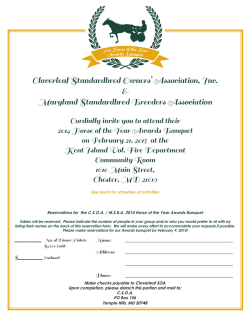
The Prescrire Awards 2014
Translated from Rev Prescrire February 2015; 35 (376): 85-88 The Prescrire Awards 2014 The three annual Prescrire Awards, for Drugs, Packaging and Information, are granted in total independence by the Prescrire Editorial Staff. These awards complement the annual review published at the beginning of each year in our French edition and a review of new drugs and indications in 2014 to be published in the April issue of Prescrire International. The rules governing the Prescrire Awards are available online at english.prescrire.org. 2014 Prescrire Drug Awards Products evaluated during the previous year in the New Products section of our French edition are eligible for the Prescrire Awards for new drugs and indications. E ach month, the Prescrire Editorial Staff presents systematic comparative analyses of available data on drugs newly approved in France, and on new therapeutic indications granted for existing drugs. The goal is to help the reader distinguish, among the plethora of lavishly promoted commercial products, those medications worth adding to their drug list or worth using instead of existing products, as well as products to be avoided. This evaluation is based on rigorous procedures that include a thorough literature search, input from a group of reviewers (specific to each project), and various quality controls to verify that the text is consistent with the data in the references (see our website for further information: english.prescrire.org). Total independence. This work is carried out by the Prescrire Editorial Staff in total independence, free from any industry or institutional influence. Prescrire is financed exclusively by its subscribers. Neither the French nor the English edition carries any paid advertising, nor do we receive grants or subsidies of any kind (see our annual financial report in each June issue of Prescrire International). At the end of each year, the Prescrire Drug Awards are based on the review articles published that year in the French edition, and take into account any new data available since the initial articles were published. Pilule d’Or/Golden Pill The Pilule d’Or (Golden Pill) has been granted since 1981 to drugs that constitute a major therapeutic advance in a field in which no treatment was previously available. ORPHACOL° (cholic acid) Cell Therapies Research & Services (CTRS) 2014 Given the seriousness of certain hereditary bile acid deficiencies, which are usually fatal during childhood, cholic acid is a major advance that prolongs survival considerably, provided treatment is initiated early (Prescrire Int n° 157) 2007 (Prescrire Int n° 94) CARBAGLU° (carglumic acid) (a second look) 2006 (Prescrire Int n° 88) ORFADIN° (nitisinone) 1998 (Prescrire Int n° 40) CRIXIVAN° (indinavir ) 1996 (Prescrire Int n° 28) DIGIDOT° (digoxin-specific antibody ) (1) 1992 (Prescrire Int n° 4) SURFEXO° (pulmonary surfactant ) (1) 1989 (Rev Prescrire n° 92) EPREX° (epoetine alfa ) • MECTIZAN° (ivermectin ) 1988 (Rev Prescrire n° 81) LARIAM° (mefloquine ) • RETROVIR° (zidovudine ) 1987 (Rev Prescrire n° 71) LUTRELEF° (gonadorelin ) • DECAPEPTYL° (triptorelin ) 1986 (Rev Prescrire n° 61) ZOVIRAX° iv and tablets (aciclovir ) 1983 (Rev Prescrire n° 31) LOPRIL° (captopril ) 1981 (Rev Prescrire n° 10) HEVAC B° (hepatitis B vaccine ) No Golden Pill was awarded in 1982, 1984, 1985, 1990, 1991, 1993, 1994, 1995, 1997, 1999, 2000, 2001, 2002, 2003, 2004, 2005, 2008, 2009, 2010, 2011, 2012 or 2013. 1- No longer marketed in France. PAGE 74 • PRESCRIRE INTERNATIONAL MARCH 2015/VOLUME 24 N° 158 These awards honour drugs that constitute a therapeutic advance, in that they offer better efficacy, fewer or less severe adverse effects (for similar efficacy), or safer or easier administration. The rules governing the Drug Awards are available online, at english. prescrire.org. 2014: a good vintage. Five drug awards have been earned this year: one Golden Pill, which has not happened in six years, three products have been included on the Honours List, and one was deemed “Noteworthy”. Three of the drugs honoured this year (Orphacol°, Glivec° and Pheburane°) are treatments for rare diseases. Golden Pill for Orphacol° (cholic acid). Cholic acid (Orphacol°) constitutes a major advance for patients with one of the rare hereditary defects of primary bile acid synthesis, which are usually fatal during childhood. It prolongs survival considerably, provided treatment is initiated early. This drug has been in use in France for some time, but only through a temporary (compassionate) authorisation programme. It has been awarded a Golden Pill because its development and European marketing authorisation (MA) represent an important event for patients. Three drugs on the Honours List and one Noteworthy. In children with a rare form of acute lymphoblastic leukaemia, with Philadelphia chromosome, the tyrosine kinase inhibitor imatinib (Glivec°) prolongs survival considerably. However, when Glivec° was authorised for this indication, it was not marketed in a dosage form appropriate for children. Severe malaria is rare in France, but a leading cause of death worldwide. Intravenous artesunate (Malacef°) has become the standard treatment for severe malaria. It is available in France through a temporary authorisation programme involving collection of data on the treated population. As of end of 2014, no companies have submitted a MA application to the European Medicines Agency for this drug. In many patients with chronic hepatitis C in whom pharmacological treatment is justified, the NS5B polymerase inhibitor sofosbuvir (Sovaldi°) is an antiviral that is at least as effective as viral protease inhibitors and enables a Honours List Drugs are included on the Honours List because they represent a clear advance for some patients compared with existing therapeutic options, albeit with limitations. 2014 • GLIVEC° (imatinib) Novartis Pharma – Acute lymphoblastic leukaemia in children (Prescrire Int n° 157) • MALACEF° (intravenous artesunate) MA holder in China: Guilin Pharmaceutical, importer and distributer in France: ACE Pharmaceuticals – Severe malaria (Prescrire Int n° 154) • SOVALDI° (sofosbuvir) Gilead Sciences – Hepatitis C (Prescrire Int n° 156) 2010 (Prescrire Int n° 114) • Glivec° (imatinib) (unresectable or metastatic gastrointestinal stromal tumours, with more follow-up) 2007 (Prescrire Int n° 98) • Glivec° (imatinib) (chronic myeloid leukaemia, with more follow-up) • Herceptin° (trastuzumab) 2006 (Prescrire Int n° 84) • Egaten° (triclabendazole ) 2005 (Prescrire Int n° 77) • Varivax° (varicella-zoster vaccine) 2004 (Prescrire Int n° 76) • Diacomit° (stiripentol ) • Fuzeon° (enfuvirtide ) • Morphine Aguettant° syrup (oral morphine) (1) 2003 (Prescrire Int n° 66, 69,74) 2002 (Prescrire Int n° 67,61) • Replagal° (agalsidase alfa ) (2) • Ceprotin° (1) - Protexel° (human protein C) • Stromectol° (ivermectin ) (scabies) 2001 (Prescrire Int n° 53) • Esterasine° (C1 esterase inhibitor) (1) • Trolovol° (penicillamine ) (chelator) • Carbaglu° (carglumic acid ) • IVheBex° (hepatitis B immunoglobulin) • Meningitec° (conjugate meningococcal C vaccine) 2000 (Rev Prescrire n° 214) • Remicade° (infliximab ) Drugs were included on the Honours List every year between 1981 and 2007. No drugs were included in 2008, 2009, 2011, 2012 or 2013. The full list of drugs included on the Honours List from 1981 to 2013 can be found in Prescrire International n° 147 page 79. 1- No longer marketed in France; 2- New data published after the inclusion of this drug on the Honours List led us to revise our rating, see Prescrire Int n° 67 Noteworthy Drugs deemed “Noteworthy” provide a modest improvement in patient care. 2014 • PHEBURANE° (sodium phenylbutyrate coated granules) Lucane Pharma – Urea cycle disorders (Prescrire Int n° 157) shorter treatment duration, thus reducing the overall toxicity of antiviral therapy. Yet there are uncertainties about its long-term efficacy and its adverse effects. Its price is exorbitant, bearing little relation to research and production costs, with dangerous implications for any system of universal health care. For patients with one of the rare urea cycle disorders, sodium phenylbutyrate prolongs survival but has only modest benefits on psychomotor retardation. The coating on Pheburane° sodium phenylbutyrate granules is an advance because it masks the drug’s unpleasant taste, which caused nausea and vomiting and compromised treatment adherence. Is this year an exception or the start of a new trend? It has been twenty years since so many drugs received Prescrire Drug Awards. Let’s hope, for patients’ sake, that this is the start of a lasting trend rather than a one-off occurrence. ©Prescrire PRESCRIRE INTERNATIONAL MARCH 2015/VOLUME 24 N° 158 • PAGE 75 2014 Prescrire Packaging Awards The Packaging Awards focus on the quality of the packaging of drugs evaluated in 2014 in the New Products section of our French edition. 2014 Packaging Award • Mirvaso° gel Galderma International (brimonidine) (Rev Prescrire n° 373) The child-proof cap on the tube is difficult to unscrew, thus preventing accidental ingestion by children, which can have serious adverse effects. P rescrire’s systematic analyses in the New Products section include evaluation of the drugs’ packaging: is it clear from the labelling which active substance or substances the product contains? How are doses prepared and administered? Does the information in the patient leaflet help users prepare doses correctly or are errors likely? Many factors are taken into account when analysing the quality of a drug’s packaging and how convenient it is to use: the situations in which the drug will be administered; the patients concerned, in particular vulnerable populations such as children, pregnant women and elderly patients; and the setting in which it will be used (hospital or community) and supplied (on prescription only, over the counter at a pharmacy, or off the shelf). Every aspect of the packaging articles, their quality, safety and dangers, are examined: the information on the labelling that is useful for patient care, especially the legibility of international nonproprietary names (INNs) and the dose strength; information presented graphically, such as dosing schedules and pictograms; any devices provided for drug preparation or administration; the quality and clarity of the patient leaflet, in particular information about how to prepare the doses to be administered, adverse effects, the situations and patient groups in which the drug is dangerous or must be avoided; and the measures taken to protect children from accidental ingestion. The Packaging Awards are granted at the end of each year based on a review of the year’s systematic analyses by Prescrire’s Packaging Working Group, in total independence, free from any influence from pharmaceutical companies or packaging manufacturers. The rules governing the Packaging Awards are available online, at english.prescrire.org. Red cards Dangerous shortcomings in the information on the labelling or patient leaflet • HumexLib état grippal° powder for oral solution in sachets (paracetamol + pheniramine + vitamin C) Urgo (Rev Prescrire n° 368) The manufacturer has chosen to print “Humex°” in bold on the box, in much larger characters than the nonproprietary names of the active ingredients, making it harder to see that it contains paracetamol. “Humex°” is displayed in this way on the boxes of the 20 or so products in this umbrella brand, each containing very different drugs. • Surbronc toux sèche dextrométhorphane sans sucre° oral solution in sachets (dextromethorphan) Boehringer Ingelheim (Rev Prescrire n° 374) The INN is insufficiently visible on the box of this new umbrella brand, which also features an illustration of someone downing a drink in one, captioned “lemon punch flavour”: a message that trivialises the dangers of an opioid that is sometimes misused as a recreational drug. • AdvilMed° 100 mg and 400 mg tablets, 5% gel, oral suspension (ibuprofen) Pfizer Santé Familiale (Rev Prescrire n° 369) (a) • Antarène Codéine° 200 mg/30 mg and 400 mg/60 mg tablets (ibuprofen + codeine) Élerté (Rev Prescrire n° 372) • Cartrex° tablets (aceclofenac) Almirall (Rev Prescrire n° 374) • FlectorEffigel° 1% cutaneous gel (diclofenac) Genévrier (Rev Prescrire n° 371) • Ibufetum° 5% cutaneous gel (ibuprofen) Menarini (Rev Prescrire n° 366) • NurofenCaps° 400 mg soft capsules (ibuprofen) Reckitt Benckiser Healthcare (Rev Prescrire n° 369) • VoltarenActigo Intense° 2% cutaneous gel and VoltarenSpé° 1% cutaneous gel (diclofenac) Novartis Santé Familiale (Rev Prescrire n° 364 and n° 374) These patient leaflets contain insufficient information about the harms of nonsteroidal anti-inflammatory drugs (NSAIDs) during pregnancy. They fail to warn patients about concerns that NSAIDs may provoke PAGE 76 • PRESCRIRE INTERNATIONAL MARCH 2015/VOLUME 24 N° 158 spontaneous abortion and malformations when taken during the first trimester of pregnancy, or about the sometimes irreversible renal damage reported in children following exposure to an NSAID during the second trimester. These leaflets only state that the product concerned is contraindicated from the sixth month of pregnancy. It would be better to avoid NSAIDs throughout pregnancy until this six-month cut-off has been shown to be relevant. Packaging that poses a risk for children • Biocadextro enfants sans sucre° syrup (dextromethorphan) Zambon (Rev Prescrire n° 373) • Clarix toux sèche codéthyline sans sucre° oral solution (ethylmorphine) Cooper (Rev Prescrire n° 365) (a) • Fluimucil toux sèche dextrométhorphane adultes sans sucre° syrup (dextromethorphan) Zambon (Rev Prescrire n° 374) (a) • Kaneuron° oral drop solution (phenobarbital) SERB (Rev Prescrire n° 372) • Potassium Richard 3 pour cent° syrup (potassium) Richard (Rev Prescrire n° 369) (b) • Primpéran° oral solution (metoclopramide) Sanofi Aventis (Rev Prescrire n° 373) • Rivotril° oral drop solution (clonazepam) Roche (Rev Prescrire n° 373) • Tanakan° oral solution (Ginkgo biloba) Ipsen Pharma (Rev Prescrire n° 365 and n° 368) • Toplexil° syrup and Toplexil sans sucre° oral solution (oxomemazine) Sanofi Aventis (Rev Prescrire n° 365) None of the bottles of these 10 products has a child-proof cap. They therefore expose children to the risk of massive ingestion and potentially serious adverse effects. a- This product belongs to an umbrella brand. b- No dosing device is supplied in the box. Users are therefore forced to measure doses using a household spoon, a cause of dosing errors. A few advances in 2014, but dire packaging persists. This year, for the first time, a child-proof cap was seen on a tube of cutaneous gel, namely brimonidine gel, authorised in the EU for the treatment of rosacea. This cap was difficult to unscrew in our tests and is a useful means of protecting children from accidental ingestion, which was reported during the development of this drug, provoking serious adverse effects (respiratory disorders, arrhythmia, psychomotor hyperactivity). In contrast to this advance, numerous examples of dangerous packaging were again identified in 2014, with about 30 pharmaceuticals receiving a Red or Yellow Card. This year’s Packaging Awards once again highlight the dangers of umbrella brands in the pharmaceutical field, in which similar-looking boxes obscure the fact that the products contain very different drugs. ©Prescrire Yellow cards • Azyter° eye drops (azithromycin) Théa (Rev Prescrire n° 369) • Monoprost° eye drops (latanoprost) Théa (Rev Prescrire n° 366) • Naabak° eye drops (N-acetylaspartyl-glutamic acid) Théa (Rev Prescrire n° 371) • Tanakan° tablets (Ginkgo biloba) Ipsen Pharma (Rev Prescrire n° 365) The primary packaging (single-dose containers or blister packs) of these four products fails to mention the nonproprietary name. • Orofluco° capsule (fluconazole) Majorelle (Rev Prescrire n° 373) The international nonproprietary name is not printed on the front of the box. • Diffu K° capsules (potassium chloride) UCB Pharma (Rev Prescrire n° 369) The strength is expressed differently on the various packaging articles, e.g. 313 mg of potassium on the box and 600 mg of microencapsulated potassium chloride on the blister packs, which could cause dosing errors. • Selincro° (nalmefene) Lundbeck (Rev Prescrire n° 374) The labelling of the blister packs is ambiguous: the packs are divided into pairs of tablets by perforations, and the international nonproprietary name and dose strength are printed just once across each pair of blister pockets. Patients could understand this to mean that the contents of two blister pockets correspond to one dose, leading to ingest a double dose. • Salbumol° 0.5 mg/1 ml solution for injection and Salbumol fort° 5 mg/5 ml solution for IV infusion (salbutamol) GlaxoSmithKline (Rev Prescrire n° 366) The graphics on the two boxes are similar and they could be confused, resulting in dosing errors. 2014 Prescrire Information Awards The Information Awards focus on the information provided to Prescrire by the pharmaceutical companies whose products we examined in the New Products section of our French edition in 2014. Honours List (in alphabetical order) • Oustanding: CTRS (Cell Therapies Research & Services), EG Labo, Lucane Pharma, Mayoly Spindler • Followed by: Arrow Génériques, Bioprojet Pharma, GlaxoSmithKline, Mylan, Novartis Vaccines and Diagnostics, SERB Red cards (in alphabetical order) Almirall, Bayer Healthcare, Biogen Idec, Bristol-Myers Squibb, Celgene, Genzyme (Groupe Sanofi), Gilead Sciences, Janssen-Cilag, Menarini, MSD, Novartis Pharma, Pfizer, Sanofi-Aventis P rescrire’s reviews are based on a thorough literature search. Pharmaceutical companies hold a wealth of information on the drugs they market or withdraw from the market. Prescrire requests such data (mainly clinical data, packaging, and administrative and regulatory information) so that we can compare or add them to information obtained from other sources. As is the case with the other Prescrire Awards, the Information Awards are granted in total independence, free from any industry or institutional influence. The rules governing the Information Awards are available online, at english.prescrire.org. Some companies are transparent, others uncooperative. On the whole pharmaceutical companies provide Prescrire with a lot of information, some new and some that we have obtained elsewhere. Certain companies respond to our requests in a timely manner and provide us with relevant, detailed documentation, including unpublished data. These companies are placed on the Honours List. The companies rated as “Outstanding” provided us with exhaustive and detailed data, without delay and sometimes without being asked. Other drug companies fail to respond to some or all of our requests for information, or provide only limited data. Some of them delay their response, then fail to provide usable information. Others omit the most relevant data. “Red cards” are given to highlight persistent shortcomings in the provision of information by some drug companies. Yet transparency is a sign of a responsible company, determined to make health care safer by withholding none of the data obtained during the evaluation of their drugs, including their limitations. ©Prescrire PRESCRIRE INTERNATIONAL MARCH 2015/VOLUME 24 N° 158 • PAGE 77
© Copyright 2025




